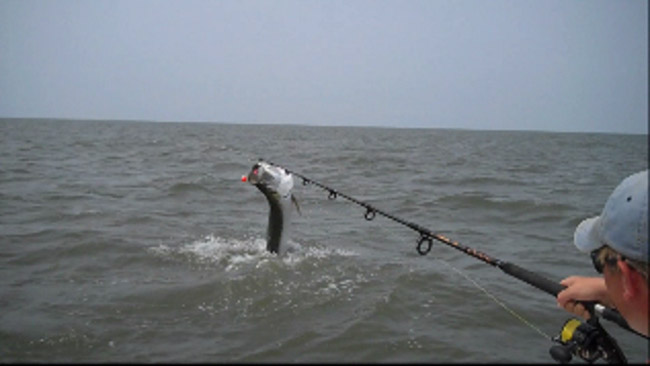
Capt. Steve Roff of Barrier Island Guide Service said a big concentration of tarpon is just south of Georgetown should move into the area by the first week of June.
If you thought tarpon were a fish only of the Florida Keys, Roff is ready to set you straight.
“It used to be a big deal to catch a tarpon. Now, it’s becoming a dependable fishery,” Roff said of the Pametto State’s fishery for silver kings.
“South Carolina is a perfect habitat,” Roff said, “because we have more food here. The tarpon come up from the south following the bait – menhaden and mullet – up the freshwater rivers and bays.”
Roff (843 446-7337) ought to know about migrating fish because he is a marine biologist who, for the past two years, has helped researchers from the University of Miami tag and release tarpon off the South Carolina coast. These tarpon are equipped with satellite tags that help scientist track their migrations and behaviors.
Tarpon usually spend June through October off the South Carolina coast, and when they really arrive, Roff said his parties can expect between five to six bites a day from tarpon that weigh from 80 to 170 pounds.
Roff likes to fish a falling tide, but no one tide determines when the tarpon will start rolling. Fish can be off beaches and estuaries near Georgetown, and there can be between 20 to 30 fish sitting on the other side of a sand bar waiting as the bait washes over.
While working the open water and looking for tarpon rolling, Roff uses a trolling motor to slip up on the fish.
“We like to easy up on the fish with the sun to our back and cast well ahead of the fish and bring your bait, fly or lure in front of the rolling tarpon,” he said.
If the fish are close to the surface, Roff will throw jointed soft plastics or big Bomber lures with a blade on the back. As far as live baits, he fishes 8- to 9-inch live mullet, croaker or whiting.
When fishing live bait, Roff uses a float rig, hooks the bait inside the top lip and runs a pink skirt in front of the bait. He fishes 165-pound braided line with a 6- to 7-foot leader of 125-pound test with an 8/0 Octopus circle hook.
A light drag is employed for runs when the tarpon start ripping off line. When the tarpon jumps, an angler has to “bow to the king” – dropping the rod tip down to keep the fish from breaking off.
Since these fish are going to be released, Roff said it is best to cut the fight time to insure survival; the angler has to do the “down and dirty.” Keep the rod tip low and crank in using short pumps so that the tarpon cannot get air. This can reduces the fight time down from 90 to 30 minutes.
Roff said we have a lot more tarpon move along South Carolina’s coastline than most people think, and they stay here a lot longer than anybody realizes.




Be the first to comment